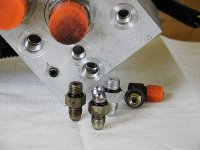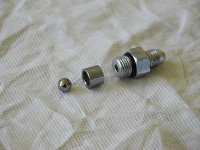Sedgewood
Platinum Member
I've been putting up with a slow hydraulic fluid leak for months now. Every now & then I would take a look around, decide it was a fitting on one of the many return lines to the tank and put off doing anything about it. They are really tough to reach and if I have to take one off, the tank has to be drained first. Procrastination rules!
Until yesterday when out mowing and the leak got suddenly much worse. As my eye passed by the RPS valve on its way to visually check out the return hoses it was arrested by a fitting that looked bent. Bent? Gwan, how can that be? Well, it was bent alright. And leaking like a sieve.
When I took the hose off and the fitting out what I found was quite astonishing.
In the picture you'll see four fittings, which we'll call 1 2 3 4 left to right. Number 1 came out of the hole directly above it. Number 2 came out of the adjacent hole (yes, the hole looks larger - I machined it to accept a larger replacement fitting (number 3). Number 4 came out of the other end of the same hole as number 2. A close examination will show some damage to the number 2 fitting - for comparison it started life identical to number 1. Also note the shape and color of the tip of number 4.
Here's what happened. The "machinist" put number 4 in its already drilled and tapped hole and ran a ball end mill (an especially long one - that aluminum block is 3 inches thick) into the hole from the number 2 end and machined a nice concavity in it's end. Then (s)he took it back out, put number 2 into it's already drilled & tapped hole and ran the ball end mill through from the number 4 side ALL THE WAY TO THE O-RING!
Why!? Beats me.
Why did the thing hold up for 400 hours? Beats me.
I hereby donate twenty lashes with a wet hose to that darn fool "machinist"
Sedgewood
Until yesterday when out mowing and the leak got suddenly much worse. As my eye passed by the RPS valve on its way to visually check out the return hoses it was arrested by a fitting that looked bent. Bent? Gwan, how can that be? Well, it was bent alright. And leaking like a sieve.
When I took the hose off and the fitting out what I found was quite astonishing.
In the picture you'll see four fittings, which we'll call 1 2 3 4 left to right. Number 1 came out of the hole directly above it. Number 2 came out of the adjacent hole (yes, the hole looks larger - I machined it to accept a larger replacement fitting (number 3). Number 4 came out of the other end of the same hole as number 2. A close examination will show some damage to the number 2 fitting - for comparison it started life identical to number 1. Also note the shape and color of the tip of number 4.
Here's what happened. The "machinist" put number 4 in its already drilled and tapped hole and ran a ball end mill (an especially long one - that aluminum block is 3 inches thick) into the hole from the number 2 end and machined a nice concavity in it's end. Then (s)he took it back out, put number 2 into it's already drilled & tapped hole and ran the ball end mill through from the number 4 side ALL THE WAY TO THE O-RING!
Why!? Beats me.
Why did the thing hold up for 400 hours? Beats me.
I hereby donate twenty lashes with a wet hose to that darn fool "machinist"
Sedgewood

